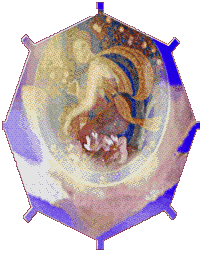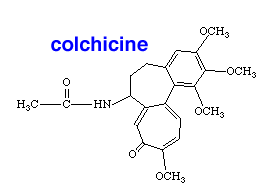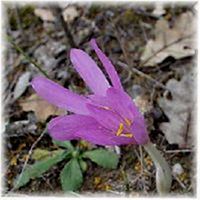CLICK: Color Control Color Choice

Though I have known about the Autumn Crocus for years, I have never chosen to grow these lovely flowers, which are exactly like a larger version of the mauve Spring crocus flower, though a bit more pointed on the petals, which are slightly more elongated than regular crocus.
This year, I had thought about getting the luxurious Autumn Crocus bulbs,thinking of the rare sight I would have in the Fall, under the tall cedar hedges, perhaps, or in front, under the Larch tree. Of course, like the hundred items that skip my mind because we need bread and cheese , or what have you, first, I didn't get around to buying the bulbs so there would be a display this Fall - maybe next Spring I will budget for the fairly costly tubers. Then again, having researched this beautiful flowering herb, I might not !
My reason for hesitating is that the plant (even its fresh juice) is a medicine which can be quite dangerous. No foolin' around, here. I wouldn't grow them in the front yard, since we have an open-plan lawn.
I actually got fascinated with researching colchicine after having read an article from a lecture series on genetics. Because Colchicum autumnale (Autumn Crocus) offers a drug called colchicine, which induces allopolyploidy ( the ability of a plant species, which has extra chromosomes, to stimulate extra warmth storage and heavy fruiting in other plants) it has been mentioned in both an American lecture series and in an article related to Agriculture Canada with regard to not only medicine, but Agriculture....
________________LLL
Definitions
Allopolyploidy:
Main Entry: al·lo·poly·ploid
Pronunciation:
"a-lO-'pä-li-"ploid
Function: noun
Date:
1928:
a polyploid individual or strain having a chromosome
set composed of two or more chromosome sets derived more or less complete from
different species
allopolyploid adjective-
al·lo·poly·ploi·dy/-"ploi-dE/
noun
Polyploidy:
Main Entry: poly·ploid
Pronunciation:
'pä-lE-"ploid
Function: adjective
Etymology: International
Scientific Vocabulary
Date:
1920: having or being a
chromosome number that is a multiple greater than two of the monoploid
number-
polyploid noun-
poly·ploi·dy
/-"ploi-dE/ noun
"Polyploidy is common among plants, and often selected for in food plants because it increases cell size and thus the size of the fruit or seed grain that is produced. Thus, potatoes, coffee, peanuts, and McIntosh apples are tetraploid, bread wheat and barley are hexaploid, and strawberries are octaploid."
With modern technology, one does not have to wait for rare natural events to convert a sterile cross-species hybrid into a fertile allotertaploid. Instead, the process can be induced by drugs such as colchicine that disrupt mitotic spindle function and allow a single nuclear envelope to reform around the duplicated chromosomes. An example is the development in Canada of a cold-resistant allotetraploid for commercial production of rapeseed (Canola) oil. Two species with haploid chromosome numbers of 9 and 10 were used to generate an allotetraploid with a chromosome number of 38......"
Continue to Read the Article: Click the link below.
"Germinating seedlings of Basin wildrye x beardless wildrye hybrids were exposed to the drug colchicine, which can interfere with mitosis and generate sectors of chromosome-doubled cell lines. This procedure appears to effectively double chromosome number in our material. For our purposes, it has advantages over colchicine treatment of whole plants or the nitrous oxide method, another procedure for chromosome doubling. This procedure will allow generation of new breeding populations, improve fertility of hybrids between species , and permit mixture of gene pools of wildryes genetically isolated because of different chromosome number."
Read the Article:
COLCHICINE DOUBLING OF GERMINATING SEEDLINGS OF INTERSPECIFIC WILDRYE HYBRIDS Author(s): JONES THOMAS A NIELSON DALE C JAUSSI HEATHER Interpretive Summary: (This article was formerly available, online, via Agriculture Canada. Another link on Cochithin doubling is below:
Read also: Colchithin Coupling
I got interested in allopolyploidal possibilities over, of all things, some Western Mountain herb that I had found growing luxuriously in our Eastern Ontario backyard. I wondered about keeping it, finding from web research that it was polyploidal as a plant, that is, it would stimulate growth and fruiting in other species. I thought of growing the equally or more stimulating Autumn Crocus for my plants, in the belief that I could actually grow better species in spite of the very cold winter months. So I linked an email to the article I had found on Colchicine and genetic capabilities, and tried to contact the elusive butterfly, Dr. Baillardgeome, whom I believed to be the head of the Plant-Gene Resource Centre for Agriculture Canada . Actually, his name is slightly different to that spelling,now, but he does exist - somewhere in stoned phytoland. I could not get a response, but I did later find the article on regular use of colchicine in Canadian Wild Rye experiments. Thanks, buds, we need tons of wild rye 'roun here, in gardenville! You can induce greater production, you say?
This site is about medicine, to be sure, and colchicine from Autumn Crocus is actually the medicine used for gout . Although I once read that Colchithin was a medicine in use for the treatment of Multiple Sclerosis, the latest essays or tables of properties state that there are two types of drug available for gout which have been made with colchicine. One is for mild cases, and the other is a very strong dose which is available for a case in crisis. Both can be considered very harmful to the human organism when mis-used.
Colchicine is an alkaloid prepared from the dried corns and seeds of Colchicum autumnale, the autumn crocus or meadow saffron. It is a pale yellow powder soluble in water in 1:25 dilution. Colchicine Tablets, USP are oral anti-inflammatory agents supplied in two dosage strengths 0.5 mg (l/120 gr) and 0.6 mg (l/100 gr).
The chemical name for colchicine is (S) N-(5,6,7,9-tetrahydro- 1,2,3, IO-tetramethoxy-9-oxobenzo [alpha] heptaien-7-yl) acetamide. Inactive Ingredients 0.5 mg tablet: Calcium carbonate, confectioner’s sugar (contains corn starch), D& C Yellow No. 10, dextrin, stearic acid, sucrose and talc. 0.6 mg tablet: Acacia, corn starch, D& C Yellow No. 10, lactose, stearic acid and talc.
Chemistry from R+X Rx List on web
Gout is defined as a condition that is caused by faulty uric acid metabolism in which excess uric acid is turned into crystals of sodium urate. The crystals get deposited in the joints (its' favourite - the big toe), causing painful inflammation.
" Researchers aren't sure exactly how colchicine works against gout, but it does seem to reduce the frequency of severe attacks and relieves residual pain."
 "Colchicine, a water-soluble alkaloid found in the autumn crocus,
blocks or suppresses cell division by inhibiting mitosis, the division of a
cell's nucleus. Specifically, it inhibits the development of spindles as the
nuclei are dividing.
"Colchicine, a water-soluble alkaloid found in the autumn crocus,
blocks or suppresses cell division by inhibiting mitosis, the division of a
cell's nucleus. Specifically, it inhibits the development of spindles as the
nuclei are dividing.
Normally, the cell would use its spindle fibers to line up
its chromosomes, make a copy of them, and divide into two new cells with each
daughter cell having a single set of chromosomes.
With colchicine present, the
spindle fibers don't form, and so the cell can't move its chromosomes around.
The cell may end up copying some or all of the chromosomes anyway, but can't
parcel them out into new cells, and so it never divides.
Because cancer cells divide much more rapidly than normal cells,
cancers are more susceptible to being poisoned by mitotic inhibitors such as
colchicine, paclitaxel, and the Vinca ....(Periwinkle...)alkaloids."
It seems evident, from the rest of the article as linked directly below, that Colchcine is actually used for the benefit of veterinary medicine, to treat some cancers in animals, but that its sole use in medicine for humans is for gout.
Read The Whole Article: Click the link below.
PHARMACOLOGY AND CONTRA-INDICATIONS
******Do not fool around with this herb unless you are licensed, since Colchine poisoning is like arsenic poisoning, and can cause eventual respiratory failure and death. It should never be administered to pregnant or breastfeeding women. On the bright side of things - who ever heard of a pregnant Mom with gout?****** *

This image of an Autumn Crocus is copyright.
Autumn crocus (Colchicum autumnale)
A conventional treatment for gout. Colchicine is much more commonly used than are herbal extracts. Both the herb and the drug have significant toxicity and for this reason should only be used under the guidance of a physician.
Devil's Claw
(Harpagophytum procumbens)
Folk remedy for the treatment of a variety of diseases, including gout and rheumatoid arthritis. Clinical research appears to indicate devil's claw may be of benefit in the treatment of gout; in addition to relieving joint pain, devil's claw also reduces serum cholesterol and uric acid levels.
Dosage: 750 mg 3 times daily of a preparation standardized to contain 3% iridoid glycosides.
Gravelroot
(Eupatorium purpureum)
This is used to stimulate elimination of uric acid
Dosage: Drink an infusion of 2 tsp gravelroot in a cup of water, three times a day.
Celery seed(Apium graveolens) :
stimulates elimination of uric acid
Dosage: Drink an infusion of 2 tsp celery seed in a cup of water, three times a day.
Half a pound (225 g) of fresh or canned cherries per day has been shown to be very effective in lowering uric acid levels and preventing attacks of gout. Cherries, hawthorn berries, blueberries and other dark red-blue berries are rich sources of anthocyanidins and proanthocyanidins. These compounds are flavonoid molecules that give these fruits their deep red-blue color. They are very effective in preventing collagen destruction. Bilberry contains compounds called anthocyanidins that have proven valuable against gout.
Others:
Nettle Root,which increases the secretion of uric acid from the kidneys,and Pine Bark,grapeseed extracts or Turmeric, which are anti-inflammatory. Celery,Birch Leaf,and Parsley Juice flush uric acid from the tissues.
(The above herb list) Copyright © 1998-2003 ICBS, Inc. Terms of Use All Rights Reserved.
Read about these remedies and very much more , in full , by linking below:
Arthritis
Colchicum is available crushed or as a freshly-pressed juice.
"Typical Dosage
For an acute attack of gout, take an initial oral dose equivalent to 1 milligram of Colchicine, followed by 0.5 to 1.5 milligrams every 1 to 2 hours until the pain subsides. Do not exceed 8 milligrams of Colchicine per day and take no additional doses for at least 3 days. For Mediterranean fever, should you choose to use Colchicum rather than antibiotics, the dosage is the equivalent of 0.5 to 1.5 milligrams of Colchicine.
Overdosage :
For adults, a dose of only 5 grams of Colchicum seeds can prove fatal. For a child, the lethal dose is 1 to 1.5 grams. A mere 200 milligrams of the active ingredient Colchicine is sufficient to cause death."
Colchicum: Somewhat Unsafe as an Herb
Autumn Crocus is also called Meadow Saffron.The herb Colchicum takes its name from Colchis, the area in which the mythical witch Medea pursued her poisonous ways. All parts of the plant are medicinal, but rarely used herbally due to the danger of poisoning.
I'm a bit of a 'survivor rabbit' (the term is from the observative slang of
Lanark, Ontario) in that I feel if there is no industry left due to some
cataclysm, some stands of even fairly rare garden flowers might be of emergency
use.
I have never met anyone with gout, and think of the problem as the arcane
distress of floridly alcoholic Victorian gentlemen of the senior persuasion.
Gout does not seem to be very common, and it has been made a d.i.s.e.a.s.e -of -
s.h.a.m.e by many cartoons depicting some fat, bald old sausage groaning away
with his foot in giant swathes of
bandage.
Animators did not reckon with the many hurt animals, who pour into our garden at night to tat and lick Physalis (also a remedy for gout) into their sore little feet. I feel that, even if you have medicine for wildlife, it will be a great advantage to you if you do become separated from civilization as a land mass!!! The animals will be very grateful, and will do favours for you.
Colchicum, which can be extremely poisonous, is used only for these two conditions -primarily for gout, but also Mediterranean fever, a painful infection usually contracted from unpasteurized milk products or direct contact with farm animals, which can be cured with a combination of antibiotics.
Before attempting to use this dangerous herb, or if planning to take a medicine made from it offered by your Doctor, Please Read the Contra-Indications as listed in the Colchicum Properties page.Know what signs to recognize, in order to report any iatrogenic disorder to your MD. Iatrogenic disorder is a problem of conflicting or improper application of pharmaceuticals.
There was a direct link to this via: Yahoo for Health Sites Pregnancy
Recent Exploration re: Colchithin and Pregnancy revealed newer info: Homeopathic Colchithin and Pregnancy
Homeopathic doses of Colchithin have been prescribed to pregnant Moms, and Homeopathy states that there is little trouble with the minute does, offered for problems of morning sickness, or with its use for other illnesses, in small doses. I feel that this may be a controversial issue.
If you link to the next site, there is a clear warning to seek your Doctors' advice during pregnacny. It is becasue Colchithin poses a risk to the foetal development. It (as Colchithine)is classified as FDA pregnancy category C drug and is known to arrest cell division.
A Statement from Colchithine Warnings: PharmaceuticalIf some of these problems are present, you may not be able to take the medicine or perhaps you will be recommended a lower dosage by your doctor.Colchicine is an FDA pregnancy category C drug and is known to arrest cell division. It has a possible effect on fetal growth. Pregnant women or expecting mothers should talk to their doctors before taking in Colchicine as it may be fatal and very risky for them and for their unborn.
Breast-feeding is not advisable for women who are nursing their infants. Although it is not known whether it can harm babies,if Cochithin is in the bloodstream, it is best to consult your doctor before breast feeding.
Also linked on the index, here is the URL of the FDA statement on pregnancy Category C pharmaceuticals.
Worth knowing about: Category C
For further info on pregnancy and health, please link to the following: Topic: Pregnancy
****************************
Author: Biological Sciences at Heriot-Watt University
************************
This article disputes the presence of colchithine in Ginko biloba products, calling the statement that pregnant women should avoid it an "unacceptable leap". Apparently there was a hue and cry back in 1996 about the supposed discovery of the medicine in Ginko biloba:
The Herb Research Foundation
TO: The Herb Reseach Foundation
South African Electronic Package Inserts
Read about brands or strengths of colchicine medicines from the writers of Pharmaceutical package inserts.
LINK: TO: Pharmacology